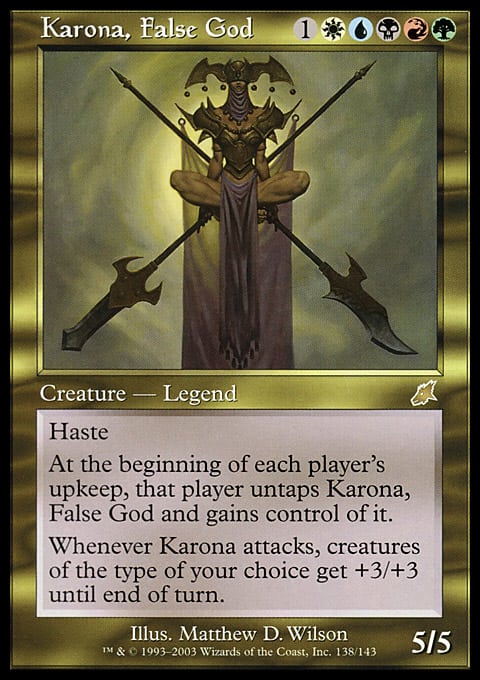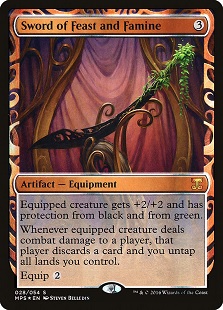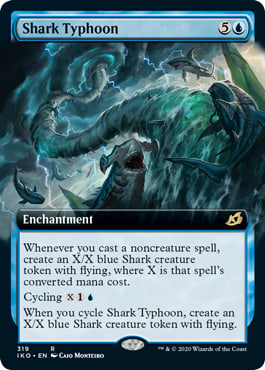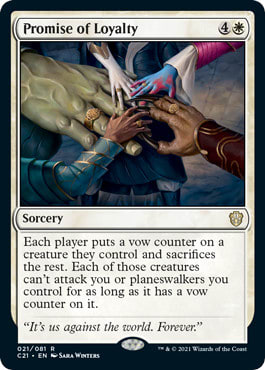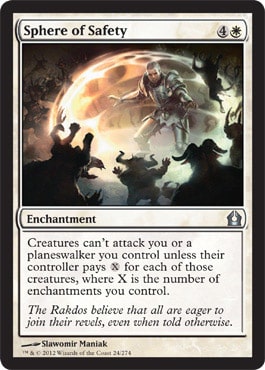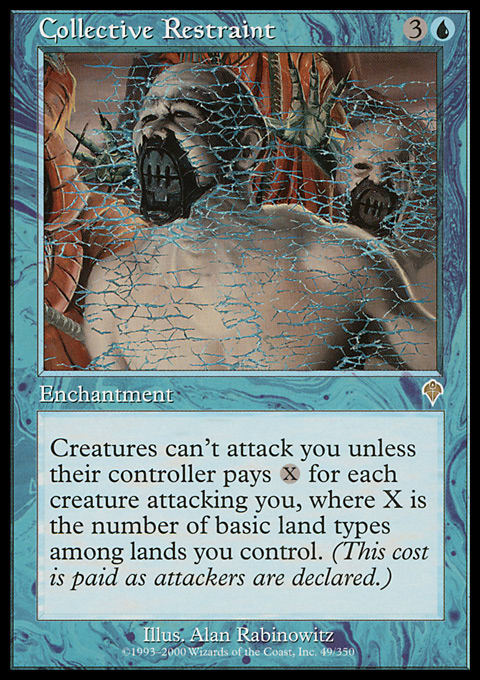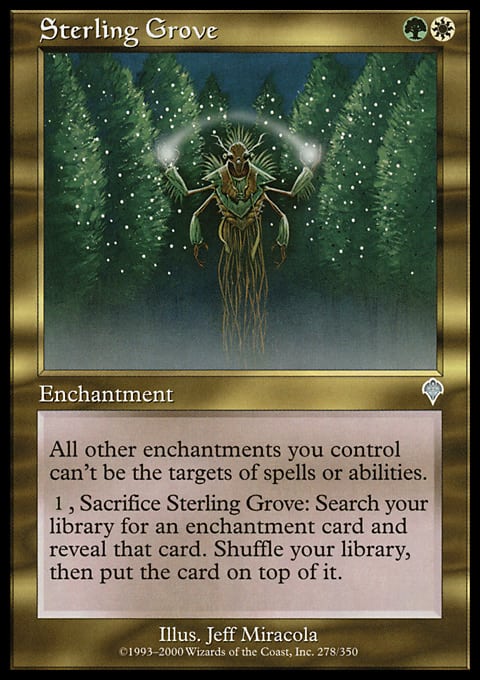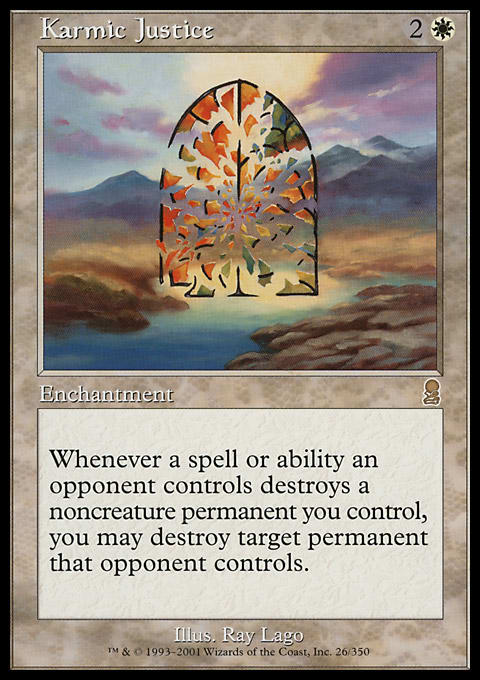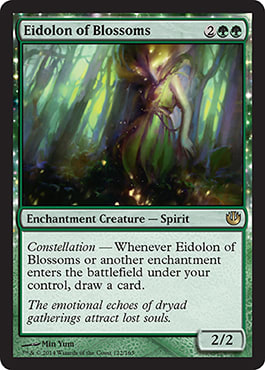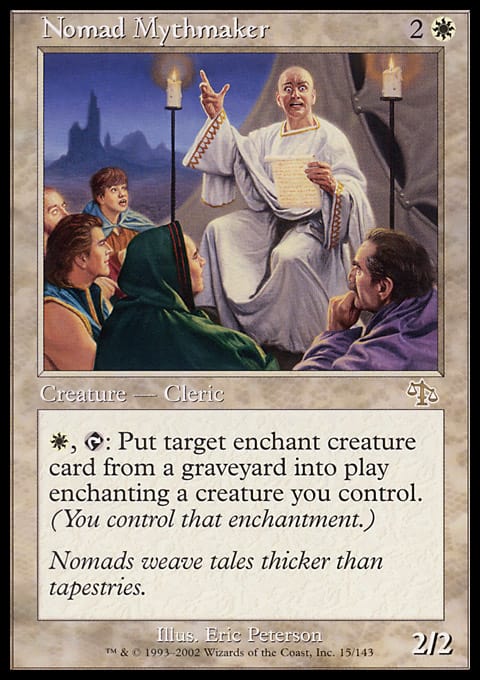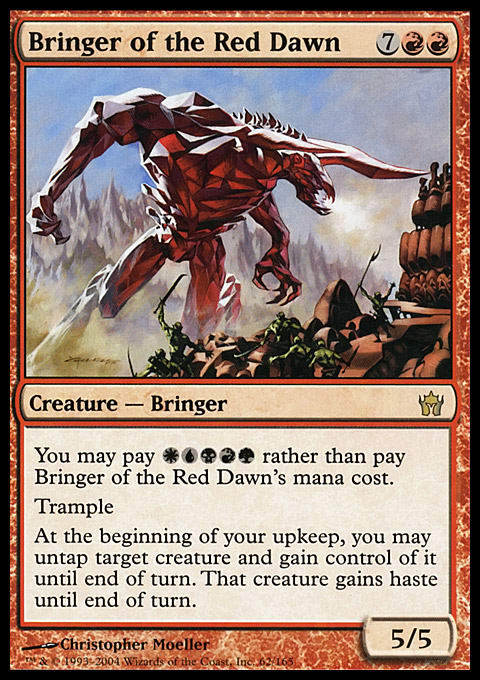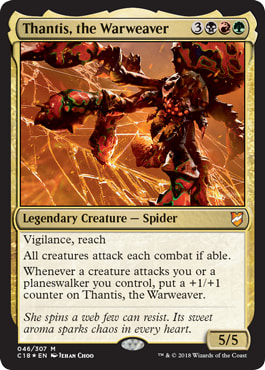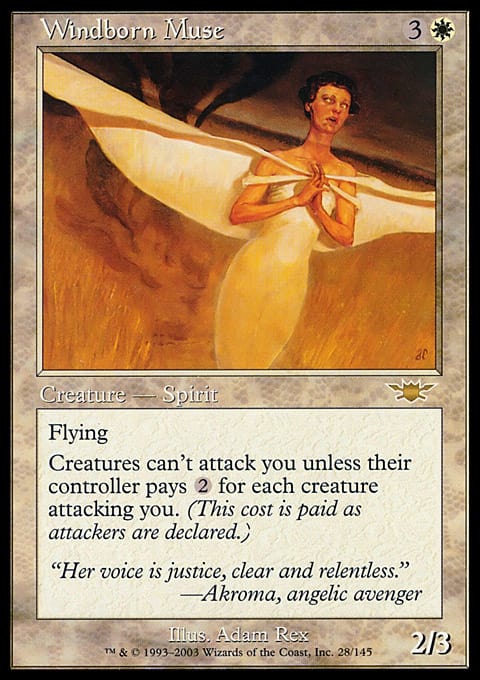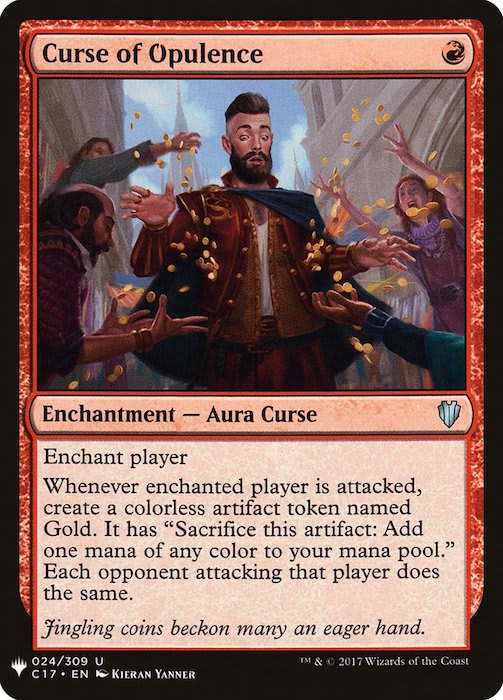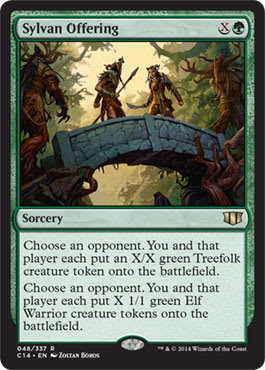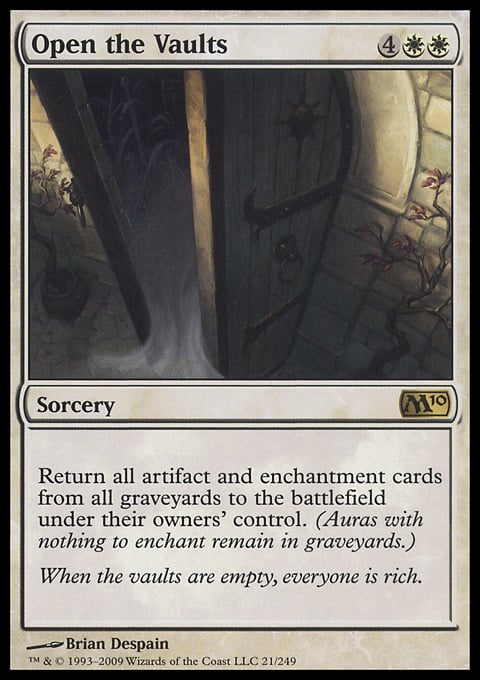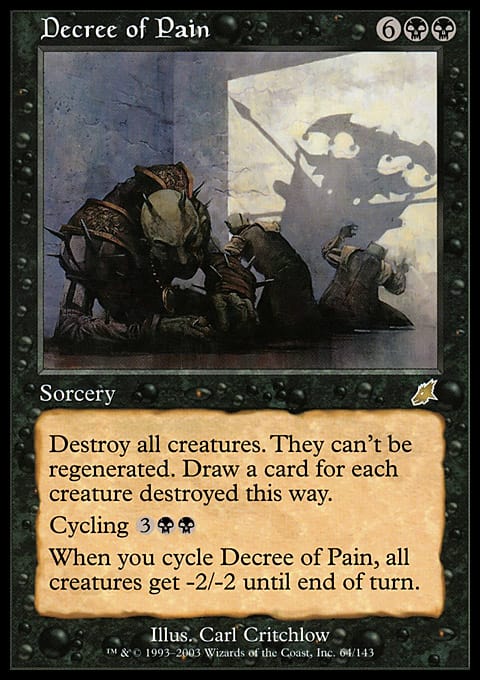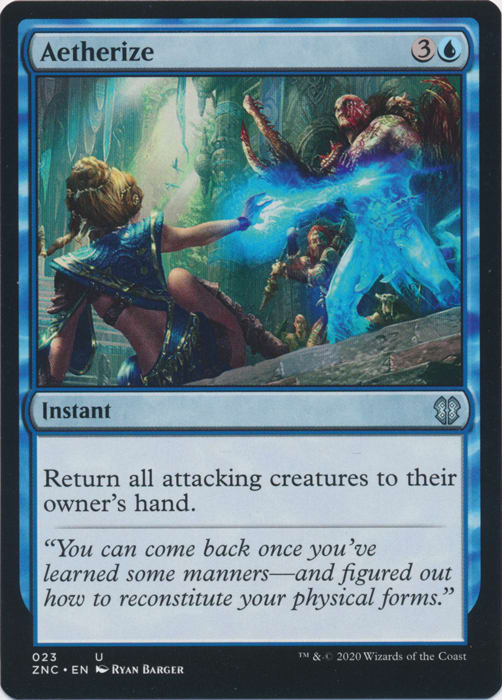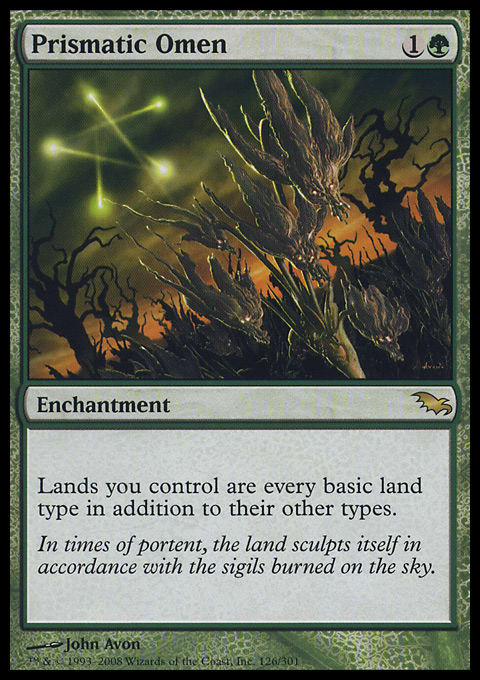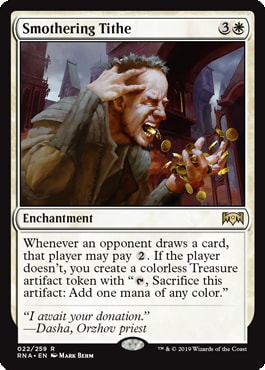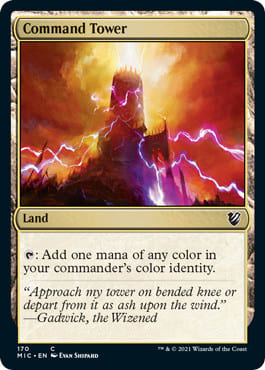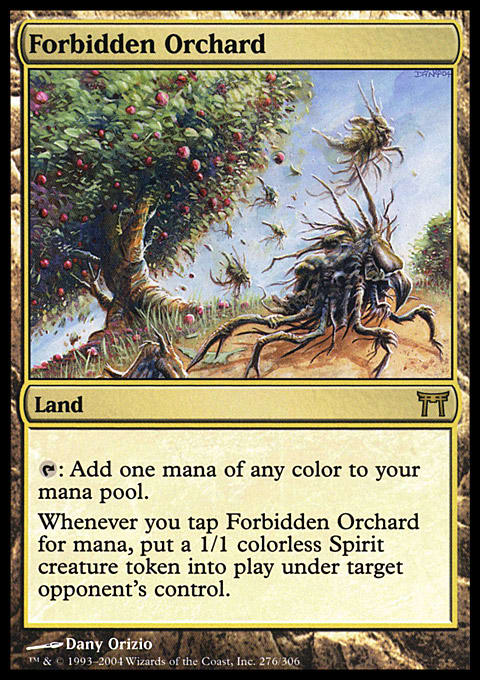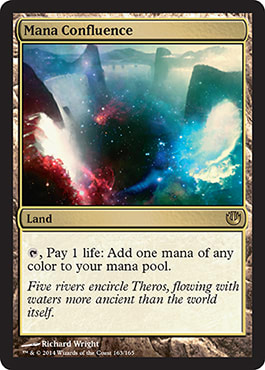When the embodiment of death meets an avatar of vengeance, the result is a demigod.

Karona, False God by Matthew D. Wilson
We've reached the finale, the conclusion of the Onslaught block. The culmination of countless battles between Phage the Untouchable and Akroma, Angel of Vengeance. A twisted corruption of Jeska, Warrior Adept versus a dreamborn warrior from the mind of Ixidor, Reality Sculptor. And throughout these clashes, a desperate Kamahl, Fist of Krosa just trying to keep chaos contained. Kamahl sought to eliminate Akroma and break through the Phage-curse to get his sister back, but in his quest to do so, accidentally created something far more dangerous than either of the two put together. Ironic, considering his inadvertent creation was the two of them put together.
Enter Karona, False God, who can warp the very fabric of reality to her whim.
With that brief intro, we've summarized entire novels worth of Magic: The Gathering lore into a single paragraph. Fitting, as the game's storyline is woven directly into its DNA. The settings and characters provide Magic with so much of its identity. And few formats so deftly blend flavor and function as Commander, where you literally recruit a historical figure to lead your army. But what's the connection between these legendary cards and their actual legends? It is possible to build decks in such a way that we can see these stories play out in the course of a game? Or, if we prefer to take a more active hand, meddle with the fate of our heroes and villains?
Today, we'll delve into the ancient lore of Magic: The Gathering and fuse it with our brewing. The resulting Frankenstein's monster will stand as a fully playable Commander deck, complete with theme and synergies, that also recounts a story from Magic's fabled past. All card and deck building choices will serve to tell the tale, allowing you to regale your playgroup (while you simultaneously crush them).
So, join me, brave brewer, on this quest to recreate the past. And win while doing so.
obvious that the very face of Armageddon stares back at them.
Today's entry will vary from the typical "Lore and Consequences" recipe book. When it comes to Scourge, third set in the Onslaught Block, we've only three Legendary creatures to work with. Karona, False God is our antagonist, the entire driving force behind Scourge, so her inclusion is natural. The other two - Bladewing, the Risen and Sliver Overlord- don't factor into the plot at all. Bladewing, the Risen does provide an update on how Rorix Bladewing faired in the gladiatorial pits. Not very well, it seems. Unfortunately, his presence as a character extends no further than the cards he's printed on. When it comes to Sliver Overlord, fans of the tribe were thrilled to have another Legendary creature to build around (o.g. Sliver Queen was expensive even back then), but Slivers don't factor into Scourge in the slightest.
As such, we'll only build a single Commander deck today, with Karona, False God at the helm. Thematically, this works in our favor. Rather than the dueling-deck technique we usually employ, the nature of Karona calls for a more 'Archenemy'-style approach. As we'll come to learn, Karona has a fanatical effect on those around her, often leading them to trample over each other in a zealous scramble for her approval. She's able to utterly captivate people into worship, even without meaning to. A frightening degree of power, but one we can flavorfully build around.
Firstly, let's cover our ground rules:
1. Function comes first:
Our mission is to design a playable Commander deck that not only illustrates story arcs, but also seeks to win the game. Temple of the False God is the literal embodiment of a shrine to Karona. Thematically, a perfect connection. But with a 5-color Commander, we want nothing to do with a land that can only make colorless mana, and even then, only on occasion.
For our purposes, it's not even a consideration.
2. Flavor still dictates card selection:
A card's connection to Magic lore may disqualify it. Our 5-color deck would love to have the Triomes (Savai Triome, Ketria Triome, etc.) available as fetch targets, but alas, they are inherently linked to the plane of Ikoria. Which is odd, considering how Wizards has made a point of naming lands in a manner that doesn't link them to a given plane. In any case, we are bound by thematic rules. Don't expect Jor Kadeen, the Prevailer to wield Shadowspear. Cards can only reference planes/characters they're organically linked to. Depending on how much "narrative vs. competitive" matters to you personally, I leave it up to you to tinker with the builds as you see fit. Commander is all about creativity, after all.
3. That said, if a card could exist on another plane, it's totally up for grabs:
Today's tale may not involve Kamigawa, but I see no reason something like Forbidden Orchard is out of bounds. A land that makes 1/1 spirit tokens wouldn't look out of place in any set, and the 5-colors it provides is very important. We're allowing wiggle-room when picking cards that could feasibly slide into any narrative. In a multiverse of dragons, krakens, and other assorted monsters, a Shark Typhoon could arguably show up anywhere.
got a damn Magic card? We live in a strange world, folks.
Anyone, with our rules covered, let's move onto the story! What reality-bending shenanigans does this demigod have in store for us?
What's more, what characters have I purposely kept secret from you, my dear readers? I promise, it was for your own good. But it's unavoidable at this point. Strap in.

Scourge by J. Robert King
Scourge, by J. Robert King, is the third and final novel in the Onslaught trilogy. If you'd like to catch up on the characters/events of the previous stories, check them out here:
The events of Onslaught - "Lore and Consequences: Kamahl vs Ixidor"
The events of Legions - "Lore and Consequences: Phage vs Akroma"
Our story sparks into action directly where Legions concluded. In his attempt to destroy Akroma, Angel of Wrath with the Soul Repear, Kamahl, Fist of Krosa accidentally hit the angel, Phage the Untouchable, and a goat herder named Zagorka all in the same swing. Rather than three fatalities, the result is Karona, False God, the supposed "Mother of all Magic.". The magical nature of the Soul Reaper had combined its victims into a new, singular entity.
Initially, Karona's personality is that of a confused child. She has little idea about who she is, even what she is, much less how to wield the god-like powers crackling at her fingertips. Much like Marvel's Scarlet Witch, Karona, False God can warp the fabric of time and space. Reality magic, able to rewrite natural laws of the universe in an instant. In the hands of a tyrant, this talent would by horrifying. So, you can imagine everyone's concern when such abilities are gifted to a childlike deity. You'd assume they'd be intimidated. Well, not quite. Karona's magic comes with a side effect.

Temple of the False God by Brian Snoddy
All those who stand in Karona's presence become instantly smitten, falling to their knees in zealous devotion. The effect is unintentional, with Karona initially shocked at the fanatical acts people begin performing to worship her. Crowds begin trampling over each other just to get closer to their new god. Before long, innocents are dying without a single swing of the sword. All are intoxicated to the arrival of their new 'savior'.
Kamahl isn't immune to the fanaticism, but summons up enough wherewithal to speak plainly to Karona, False God. A former barbarian, one whose power had been amplified under the dark influence of the Mirari, Kamahl knows what tragedy unchecked power can bring about. He appeals to Karona to better understand her abilities and lead the people benevolently. In the short term, this is to stop the worshippers from killing each other. In the long term, Kamahl hopes it'll to prevent Karona from establishing herself as a tyrant and ruling over the continent.
Unfortunately, Kamahl's pleas fall on deaf ears. Rather than stop the fanatical killing, Karona simply flees, leaving a trail of bloodied followers stumbling after her. Kamahl tries to follow, but after taking a glance at the death all around him, realizes that it's already too late. Karona is too dangerous, too indifferent to how much raw power she wields. With heavy heart, Kamahl resolves to slay the demigod with the only weapon he thinks possibly could: the card]Mirari[/card.

Kamahl's Druidic Vow by Noah Bradley
And now we come to the part of the story I've been avoiding since Legions: the dreaded Unmen. The Jar Jar Binks of the trilogy. Back in Onslaught, Ixidor decided to whip up some quick escape-portals in case someone tried to assassinate him. These portals were human-shaped figures who resembled their creator. They'd follow Ixidor around, and if danger struck, the illusionist could escape through one to safety, with the unman-portal snapping shut and disappearing to prevent anyone from following. These beings were more empty vessels than characters until the duo of Sash and Waistcoat came along.
This is where art would usually go, but there's zero
picture of either character. You'll soon learn why.
Sash and Waistcoat, named for the first items of clothing they came across, were unmen who began to develop their own personalities, chief among them being "I don't want to die". So, during the battle at the finale of Onslaught, they fled their master and struck out on their own quest to figure out what it was to be human. Their bumbling adventures through Legions found them hunted by another Unman (who'd eventually sacrifice himself to save them), transformed into giant cockroaches in service of the Cabal Patriarch, and finally granted real bodies. Through it all, their survival hinged entirely on sheer luck and being at the right place at the right time. They mean well, but are about as competent at the aforementioned Gungan.
They are our comic relief characters. And guess who they're about to run into?
A fleeing Karona, False God comes across Sash and Waistcoast and immediately forms a kinship with them. Being former Unmen, whatever magic causes mortals go crazy, Karona has no effect on Sash and Waistcoat. They're both getting used to this whole "reborn" thing themselves and extend a hand of friendship to the demigod, who immediately appoints them her personal prophets. Sash and Waistcoat will now handle all P.R. associated with Karona as Otaria's new god. The most powerful being in existence paired up with two-thirds of the Three Stooges. As Ralph Wiggum would say: "I'm in danger!", except it's an entire continent full of people.
What's Kamahl up to?
Balthor the Stout to Balthor the Defiled to...
Tough break there, buddy
Snapping back to druid, we find Kamahl having difficulty traversing the Krosan forests. Waves of growth given off by the Mirari have mutated the plants and wildlife into gigantic forms, to the point where the hill the Mirari rests on has become a mountain of vines known as the Gorgon Mound. The ghost of Kamahl's former mentor, Balthor the Stout appears to provide the druid guidance, Obi Wan-style. In his barbarian days, Kamahl was trained by Balthor the Stout. Sadly, after the dwarf's heroic death and subsequent resurrection via the Cabal, Kamahl was given the grim task of slaying Balthor the Defiled. This reunion with his friend and mentor gives Kamahl great hope, but the happiness will be short lived.
Reaching the Mirari, which Kamahl had attached to his sword and pinned the corpse of Odyssey block villain Ambassador Laquatus to the ground with, the druid finds himself having to slay another zombie. Much like the wildlife, so too has the Mirari warped Laquatus into a massive undead behemoth. Luckily, zombie-Laquatus retained none of its former intelligence and is easily dispatched. Kamahl reclaims the Mirari sword, ready to put an end to Karona, False God, but finds himself once again tempted by its tremendous power. Despite the horrible acts he committed as Kamahl, Pit Fighter under the sway of the Mirari, Kamahl finds himself becoming consumed once again. The warnings of Balthor fall short as a power-mad Kamahl cleaves the ghost in two, eradicating his former mentor from existence. Kamahl's stomach drops with the realization his master is now twice dead by his own hands. Heartbroken, but sobered enough to fully resist the Mirari's sway, Kamahl briefly mourns and returns to his mission. Step Two: Find Ixidor.

Decree of Pain by Carl Critchlow
Meanwhile, the world's not responding too well to the arrival of Karona, False God. Most nations are rabidly flocking to her location. Most come to worship, but any armies sent to kill or capture her are immediately vanquished by Karona's power. One such Cabal legion, led by Braids, Cabal Minion, is instantly buried into the stone walls of a canyon, resulting in a rather anticlimactic ending for the beloved villain. The Cabal's attempts to kill Karona stem from Kuberr, the lovechild of Phage the Untouchable and the Cabal Patriarch, and now the leader of the Cabal, despite only being a teenager. Albeit, a Black-mana infused teen who ages more with each murder performed on his behalf, but a teen all the same. Despite Karona being made up, at least in-part, of his own mother, Kuberr wants nothing more than to kill the demigod.
Back to Kamahl's quest. The druid tracks down the Deathwurm that still contains a grieving Ixidor, Reality Sculptor in its guts. Akroma, Angel of Wrath's previous attempt to rescue her master was rebuked. He wishes to forever remain in the wurm and mourn his fallen lover, Nivea. Not one for patience, Kamahl isn't having any of that, and promptly slices the Deathwurm to ribbons, freeing Ixidor. Although initially enraged, a change soon comes over Ixidor, Reality Sculptor. He reveals to Kamahl that he is actually Lowallyn, a magical entity that originally granted Ixidor his powers and is now possessing his body. Lowallyn is a Numen, an embodiment of pure magical energy, stirred into action via the birth of Karona, his 'mother'. Turns out, goth-kid Kuberr is another Numen, explaining why he was so intent on killing Karona. Essentially, the continued presence of Karona will force the Numen into a form of hibernation, preventing them from exercising their power in the world. And so Kamahl teams up with the Numen, barely managing to get Kuberr out of Aphetto - capital city of the Cabal - before Karona, False God obliterates it.
By now, Karona has gone full-on goddess mode, deciding that those who worship her (most of the continent) are fine, but everyone else must suffer her wrath. Kuberr had previously sent his army, and so he and his entire city were targeted for destruction. The thing Kamahl feared most came true: Karona has become a tyrannical force. Although Kamahl and Lowallyn are able to get Kuberr out of Aphetto before it's too late, they'll need the combined power of all three Numen to defeat Karona. No biggie, as the reader is informed that the next city we visit - Averru - is itself the third and final Numen. Seems a little convenient, but what's another oddball inclusion in this already-crazy plot?
Okay, conclusion time! In their last stand against Karona, False God, Kamahl and the Numen are just about to achieve victory, when at the last second, a saboteur is revealed, allowing Karona, Sash, and Waistcoat a window to escape. That saboteur? Kamahl, Fist of Krosa himself, who realizes having the Numen dispel Karona would only be replacing a single demigod tyrant for three more! It's up to him and him alone to dispatch Karona via Plan A: The Mirari Sword. Their plan in ruins, the Numen brace for their very angry mother to return with a vengeance
card]Karona, False God[/card]'s escape takes her across the multiverse, through a canon-questionable visit to Serra's Realm and Phyrexia (both of which no longer exist at this time in the story) and finally to Mirrodin. The metal plane is brand new and shiny, with but a sole inhabitant: Lord Macht. The lonely golem tells Karona and co. that his master sent a probe back to Dominaria to see how life was doing post-Phyrexian Invasion, but the probe grew too powerful and caused more harm than good. That probe's name? The Mirari. Figures. Macht tries using the metaphor of the Mirari, a force meant for good, but ultimately corrupted through the exercise of unchecked power, to appeal to Karona. She doesn't buy his lecture and decides to return to Otaria, eager for revenge. Before they go, Macht delivers Sash and Waistcoat a final warning.

Glimmervoid by Lars Grant-West
Back on Otaria, Karona's vengeance is swift. All three Numen are wiped out with very little opposition. It's Kamahl, Fist of Krosa vs Karona, False God from here on out. The battle begins with Karona immediately using telekinesis to rip the Mirari-sword from Kamahl's hand, breaking all his fingers. The epic fight our story was leading up to? Yea, that was it. Right before Karona is able to kill Kamahl, she's stabbed from behind with the Mirari sword. And by whom, you ask? Stalwart Stonebrow, Krosan Hero? A revived Ixidor, Reality Sculptor?
Nope.
The Unman: Sash and Waistcoat. When their master's back was turned, they picked up the Mirari sword and stabbed Karona in the back. We've spent all of the Odyssey through Onslaught blocks, six novels, following the character of Kamahl. His sins in Odyssey gave rise to the entire conflict of Onslaught. Karona is the literal embodiment of Kamahl's mistakes: The creation of Phage, which gave rise to the creation of Akroma, and ultimately Karona, False God, a literal avatar of unchecked, all-powerful temptation. This should be the climax to Kamahl's redemption arc, his chance to set right all the wrong wrought by his own hands.
And Sash and Waistcoat deliver the final blow. It's like if C3PO accidentally killed the Emperor by stumbling into him just before Darth Vader could redeem himself. Our story's comic relief characters save the day.
With Karona, False God's death, Jeska is returned to her old self and revealed to be a Planeswalker. Akroma and Zagorka? Still very dead. Jeska ascends to Jeska, Thrice Reborn and is met by Lord Macht, who reveals himself to be Karn, The Great Creator. Karn offers to show Jeska the multiverse, so after a brief good-bye to her brother, everyone goes their separate ways. Kamahl and Stonebrow go off to get a drink. I can't blame them. Sash and Waistcoat once again find themselves walking away at square one. Essentially the same ending as "Dumb and Dumber". I couldn't think of a more fitting climax for those two. Karn decides to take the Mirari, give it a factory reset and sentience, and make it the caretaker of Mirrodin while he's away with Jeska.

Jeska, Thrice Reborn by Chris Rallice
Everything seems peaceful, at long last. Until the Mirari renames itself Memnarch.
And that wraps up the Onslaught novel trilogy. Between multiple rebirths, character betrayals followed by rebretrayals (Unbetrayals? What do you can betraying a betrayal?), and outright zany plot points, it's considered one of the weirder Magic: The Gathering storylines. While the story may have ended on a bit of an anticlimax, we can rewrite history via wielding Karona, False God as the sort of Archenemy-style Commander she was designed to be. Karona can hit hard on her own, and in true fanatical fashion, encourages your opponents to do the same. Turn after turn. With her as our general, our gameplan will be as follows:
1.Our plan is to let the other players do all the dirty work. And help them along the way. Karona, False God has a built-in Assault Suit and will gift any tribal synergy an Overrun effect on each of their turns, making even a small army of 1/1's able to crush opponents in a single swing or two. If our opponents have no tribal synergies, or lack creatures altogether, Karona, False God can attack on her own as an 8/8 with Haste, as she's been errata'd to the Avatar creature type. On her own, the fact that Karona, False God attacks for 8 damage on each combat means she can very easily kill players. Heck, with her jumping from player to player each turn, she has the potential to wipe out an opponent at 40+ life in a single turn cycle. Commander damage doesn't care who controls the Commander, after all.
2. That said, our opponents don't have to attack each other. Even though they should be. Opposing players can simply opt not to swing with Karona if the situation isn't tactically advantageous. No worries, as the storyline taught us a very important lesson: Karona can be very persuasive. If our opponents won't attack each other willingly, we'll simply force (Disrupt Decorum, Parasitic Impetus, Thantis, the Warweaver) or reward them (Curse of Verbosity, Tempt with Vengeance, Agitator Ant) for doing so.
3. While we want Karona to constantly on the attack, we also want to make sure that we, ourselves, never wind up in her cross-hairs. Opponents will be very eager to try to kill us with our own general. Fortunately, many of the options described above, along with a variety of other tools like Shiny Impetus, Spectral Grasp, Vow of Flight, and Promise of Loyalty help ensure Karona, False God won't be coming after us. Each of these tools could just as easily be placed onto a threatening opposing creature, especially before we're able to cast Karona, to further keep ourselves safe. With most of these tools being Enchantments, it felt suitable to enhance our defensive measures along the same lines. Sphere of Safety will scale up as we cast more and more enchantments, Collective Restraint is at its best in our 5-color build, Solitary Confinement can offer indefinite protection so long as we can find another source of card draw, and enchantments like the classic Ghostly Prison and Propaganda make the prospect of attacking us that much harder to gain value out of for our opponents.
4. Finally, with such a high number of Enchantments, we'll want elements to further enhance this subtheme. Sterling Grove is an excellent protective card with built-in tutor for whatever the situation calls for, Karmic Justice punishes anyone who tries to mess with our Enchantments, and Replenish and Open the Vault help bring them all back in the wake of a Fracturing Gust, All is Dust, or other form of mass-removal.
With our themes and general strategy covered, let's get into the advanced tech!
Akroma vs. The World | Commander | Matthew Lotti
- Commander (1)
- 1 Karona, False God
- Creatures (11)
- 1 Agitator Ant
- 1 Bringer of the Blue Dawn
- 1 Bringer of the Red Dawn
- 1 Eidolon of Blossoms
- 1 Elvish Rejuvenator
- 1 Faeburrow Elder
- 1 Nomad Mythmaker
- 1 Satyr Enchanter
- 1 Thantis, the Warweaver
- 1 Tireless Tracker
- 1 Windborn Muse
- Instants (4)
- 1 Aetherize
- 1 Beast Within
- 1 Generous Gift
- 1 Blessed Respite
- Sorceries (17)
- 1 Blasphemous Act
- 1 Cultivate
- 1 Decree of Pain
- 1 Disrupt Decorum
- 1 Edge of Autumn
- 1 Explore
- 1 Extinction Event
- 1 Farseek
- 1 Idyllic Tutor
- 1 Open the Armory
- 1 Open the Vaults
- 1 Promise of Loyalty
- 1 Ranger's Path
- 1 Replenish
- 1 Sylvan Offering
- 1 Tempt with Vengeance
- 1 Three Visits
- Enchantments (25)
- 1 Burgeoning
- 1 Collective Restraint
- 1 Curse of Clinging Webs
- 1 Curse of Opulence
- 1 Curse of Verbosity
- 1 Deathreap Ritual
- 1 Ghostly Prison
- 1 Karmic Justice
- 1 Martial Impetus
- 1 Mirari's Wake
- 1 Parasitic Impetus
- 1 Prismatic Omen
- 1 Propaganda
- 1 Psychic Impetus
- 1 Rhystic Study
- 1 Shark Typhoon
- 1 Shiny Impetus
- 1 Smothering Tithe
- 1 Solitary Confinement
- 1 Spectral Grasp
- 1 Sphere of Safety
- 1 Sterling Grove
- 1 Vow of Flight
- 1 Vow of Torment
- 1 Vow of Wildness
- Artifacts (5)
- 1 Arcane Signet
- 1 Chromatic Lantern
- 1 Coalition Relic
- 1 Commander's Sphere
- 1 Expedition Map
- Lands (37)
- 10 Forest
- 2 Island
- 2 Mountain
- 4 Plains
- 2 Swamp
- 1 Arid Mesa
- 1 Breeding Pool
- 1 City of Brass
- 1 Command Tower
- 1 Exotic Orchard
- 1 Forbidden Orchard
- 1 Mana Confluence
- 1 Marsh Flats
- 1 Misty Rainforest
- 1 Murmuring Bosk
- 1 Overgrown Tomb
- 1 Scalding Tarn
- 1 Stomping Ground
- 1 Temple Garden
- 1 Verdant Catacombs
- 1 Windswept Heath
- 1 Wooded Foothills
Our gameplan revolves around getting Karona, False God on the table as quickly as possible, blowing up any threats along the way as we build up and develop our mana. Once Karona is down, we shift gears into a different sort of defensive mode. One where we keep creatures attacking as much as possible. Just in opposite directions. When players start dying and the dust settles, we'll be able to use our own Karona, False God to finish the remaining opponent when our turn rolls back around.
Fanatical Zealots: The meat of our deck is Enchantment-based, paying homage to Karona's persuasive influence, but we do bring along a few creature-based followers. For starters, classic Enchantress-roleplayers like Satyr Enchanter and Eidolon of Blossoms are vital to keeping card draw flowing. Nomad Mythmaker is key for recycling Auras such as Parasitic Vow and Psychic Impetus, putting them onto Karona, False God during our own turn to ensure we're safe from our own general. If we're able to get a Bringer of the Red Dawn onto the table, Nomad Mythmaker will let us pull off the same trick with any opposing creature of our choosing.
When it comes to encouraging attacking, Agitator Ant rewards players for growing their attackers while providing us an ever-growing blocker. Thantis, the Warweaver works in a similar manner, just on steroids. She'll ensure everybody gets in on the attacking, but because she'll grow proportionally to the number of attackers sent our way, encourages our opponents to send their armies at each other rather than us. Sometimes the best defense is a good offense. We also could make the idea of attacking us an overall headache via the likes of Windborn Muse.
Our final bunch of creature serve to provide additional card advantage (Bringer of the Blue Dawn, Tireless Tracker) or ramp/color fixing (Faeburrow Elder, Elvish Rejuvenator). The growing ramp potential and stats on Faeburrow Elder make it both an excellent mana source and blocker as the game continues on. I'm honestly surprised that it's only $2, as it seems nigh-auto-include in 5-color decks. If you could use a copy or two, I'd recommend picking them up now.
Enchanting Influence: Wanting to rule the world with everyone else's creatures requires multiple sources of propaganda. And also Propaganda, but we'll get to that in a minute. What I mean are cards that'll steer opposing attackers (Karona, included) in the opposite direction. Disrupt Decorum is the most wide-ranging of these, but more permanent options include Vow of Flight, Vow of Wilderness, and Vow of Torment, which all enhance enemy creatures while protecting us from them. Even better are Shiny Impetus, Martial Impetus, Parasitic Impetus, and Psychic Impetus, as their Goad mechanic will force the enchanted creature to attack rather than just buff their stats. Martial Impetus has the added advantage of encouraging other creatures to go after your opponents, too!
Outside of brute force, we can also steer enemy creatures via rewarding their controllers. Curse of Verbosity and Curse of Opulence gift our enemies for going after each other. That we also benefit from this arrangement is icing on the cake. Cards like Sylvan Offering and Tempt with Vengeance hand out free creatures to our opponents. These gifts will hopefully encourage them not to attack us, but also provide us with our own blockers in case that they do. Tempt with Vengeance is a downright finisher in this build, as the player with Karona will always be attacking with 4/4 elementals against opposing 1/1 elementals. If Karona can make it back around the table to us, we're in the position of having at least twice as many elementals as everyone else. Just need to remember to keep the shields up in the meantime, as folks will hesitate to kill each other when they know our own army looms in the backgound.
Speaking of shields, few other permanents offer the range of raw defensive power as Enchantments. Classics like Ghostly Prison and Propaganda come down early and require no additional support, but work to slow the tide of war rather than outright stop it. Fortunately, as the game marches on, the likes of Sphere of Safety, Collective Restraint, Solitary Confinement, and Curse of Clinging Webs become better and better. Solitary Confinement obviously requires us to have additional sources of card advantage, so the likes of Rhystic Study and Deathreap Ritual become even more valuable. Against a token-player, Curse of Clinging Webs can generate us entire armies of blockers (or attackers pumped up via Karona) in the wake of a board wipe.
Speaking of which, Promise of Loyalty will remove most problematic creatures, but also keep you safe from the survivors. You'll often be picking Karona, False God with this, ensuring you're safe from her for the remainder of the game. Shark Typhoon provides another tool that can go from defensive to offensive in a heartbeat. A steady stream of blockers quickly becomes a deadly pack of evasive attackers once Karona comes back around the table. And with mass-enchantment return like Replenish and Open the Vaults on hand, having to Cycle the card early doesn't sting nearly as much.
Lastly, we bring in some Enchantment-centric tutors (Sterling Grove, Idyllic Tutor, Open the Armory) to grab whatever is needed most, be it card advantage, raw defensive power, or an Aura to steer attackers to our whims.
Supporting Spells: The majority of our supportive spells are removal-centric. Decree of Pain, Aetherize, Extinction Event, Blasphemous Act, and the aforementioned Promise of Loyalty all remove swaths of armies from the table at once. For more pinpoint removal, we bring in the flexible Beast Within and Generous Gift. Lastly, while I tend to avoid Fog effects in Commander, the graveyard-removal Blessed Respite tacks on allows us to hurt graveyard strategies while simultaneously protecting us for a turn.
Ramp and Lands: Running a 5-color Commander deck requires a huge commitment to mana fixing and ramp. Without the ability to cast our spells, our gameplan never lifts off the ground. Green provides the usual go-to ramp spells in Cultivate, Farseek, Three Visits, Ranger's Path, and Edge of Autumn. Mana rocks Arcane Signet, Commander's Sphere, Chromatic Lantern, and Coalition Relic produce multiple colors, and spells like Explore and Burgeoning help us get ahead on land count quickly. Expedition Map ensures we find the mana source we need most, most often grabbing us something like Command Tower for full 5-color support.
Powerhouses Smothing Tithe and thematically-perfect Mirari's Wake also provide large bursts of mana, pivotal in getting Karona, False God onto the table quickly.
While we won't go so far as to bring in traditional duals (Taiga, Tundra, etc.) due to high prices, we won't shy from bringing in a whole host of fetch lands. I've specifically included the Green-centric ones (Verdant Catacombs, Misty Rainforest, Windswept Heath, Wooded Foothills) in this build, but if you have them, by all means feel free to add the likes of Scalding Tarn, Polluted Delta, etc. Although we're prohibited from running the Triome cycle, the Green-centric Shocklands Temple Garden, Breeding Pool, Stomping Ground, and Overgrown Tomb are all on hand to fetch, alongside Murmuring Bosk. Like with the Fetchlands, feel free to add/subtract as many Shock lands as you wish, depending on what's in your collection. We don't want to have to worry about lacking access to colors, so heavy emphasis on fetch lands and shock lands is key.
In addition, we include lands that produce all five colors of mana on their own: Command Tower, Mana Confluence, City of Brass, Exotic Orchard, and Forbidden Orchard. The spirits produced by Forbidden Orchard may accumulate to enough of a degree to become quite the deadly force once Karona show up, so be sure to either spread them out or grant them to a single opponent with assurances they won't attack you with them. End of the day, you're giving your opponent free 1/1's, so there's some bargaining power there.
With fetch lands and shock lands being expensive, feel free to substitute budget alternatives such as Cascading Cataracts/Crystal Quarry, the Tri-Land cycles from Shards of Alara and Khans of Tarkir (Seaside Citadel, Frontier Bivouac, etc.) the Battle for Zendikar cycle (Smoldering Marsh and co.), and the Amonkhet cycling lands (Irrigated Farmland and co.). A key component of the latter two cycles is how they retain the land types - Plains, Island, etc. - allowing them to be searched for via ramp spells.

Kamahl, Heart of Krosa by Kekai Kotaki
At the end of the day, a nigh-unstoppable force was brought down not by the heroic druid, but rather her own bumbling henchmen. Not the most dignified way to go, but with Karona, False God at the helm of your Commander deck, history is yours to rewrite. It's time to round up some followers and begin convincing your enemies to start going after each other. We'll continue to explore new realms and legends in future installments, and if you've any recommendations or requests, feel free to let me know in the comments.
What characters and stories would you like to see next?
Thanks for reading, and remember: If you suddenly find yourself in possession of godlike powers, try not to let them go to your head.
-Matt Lotti-

















